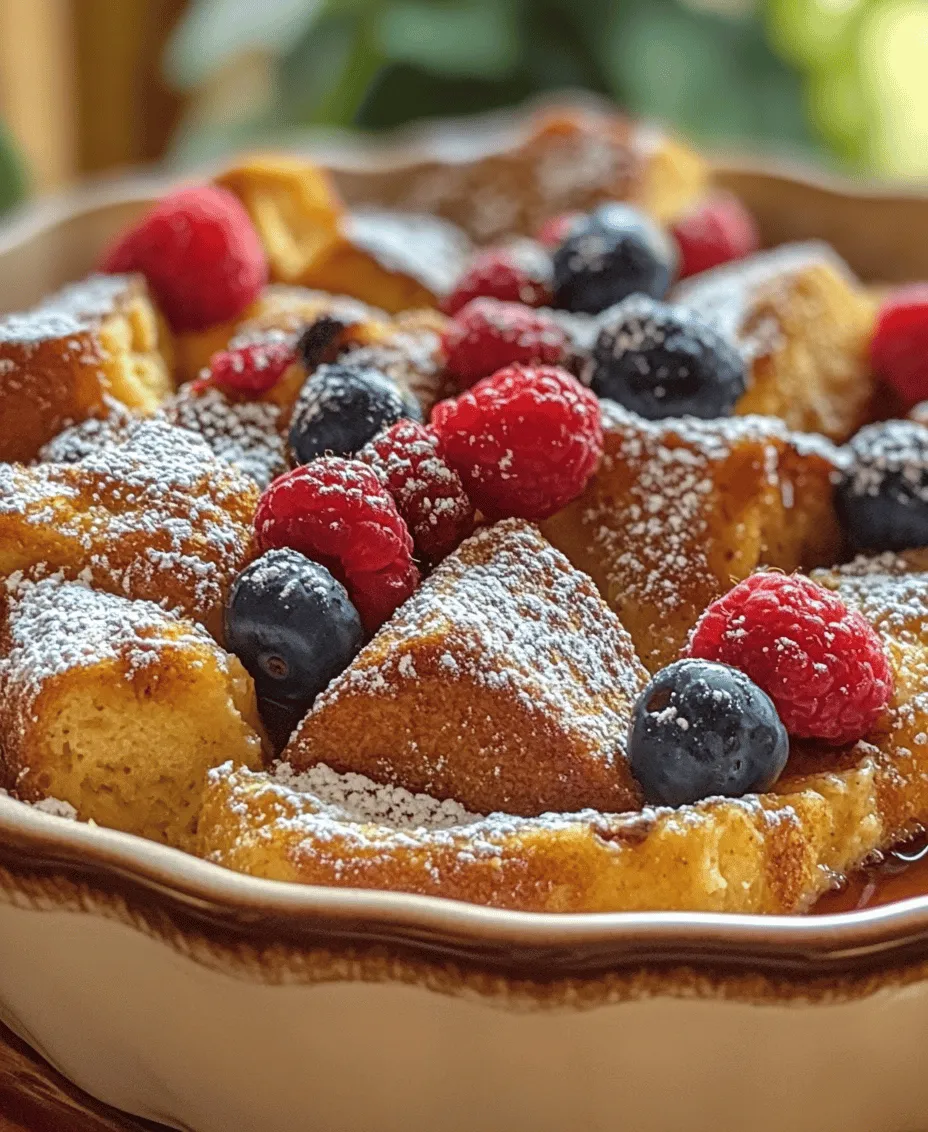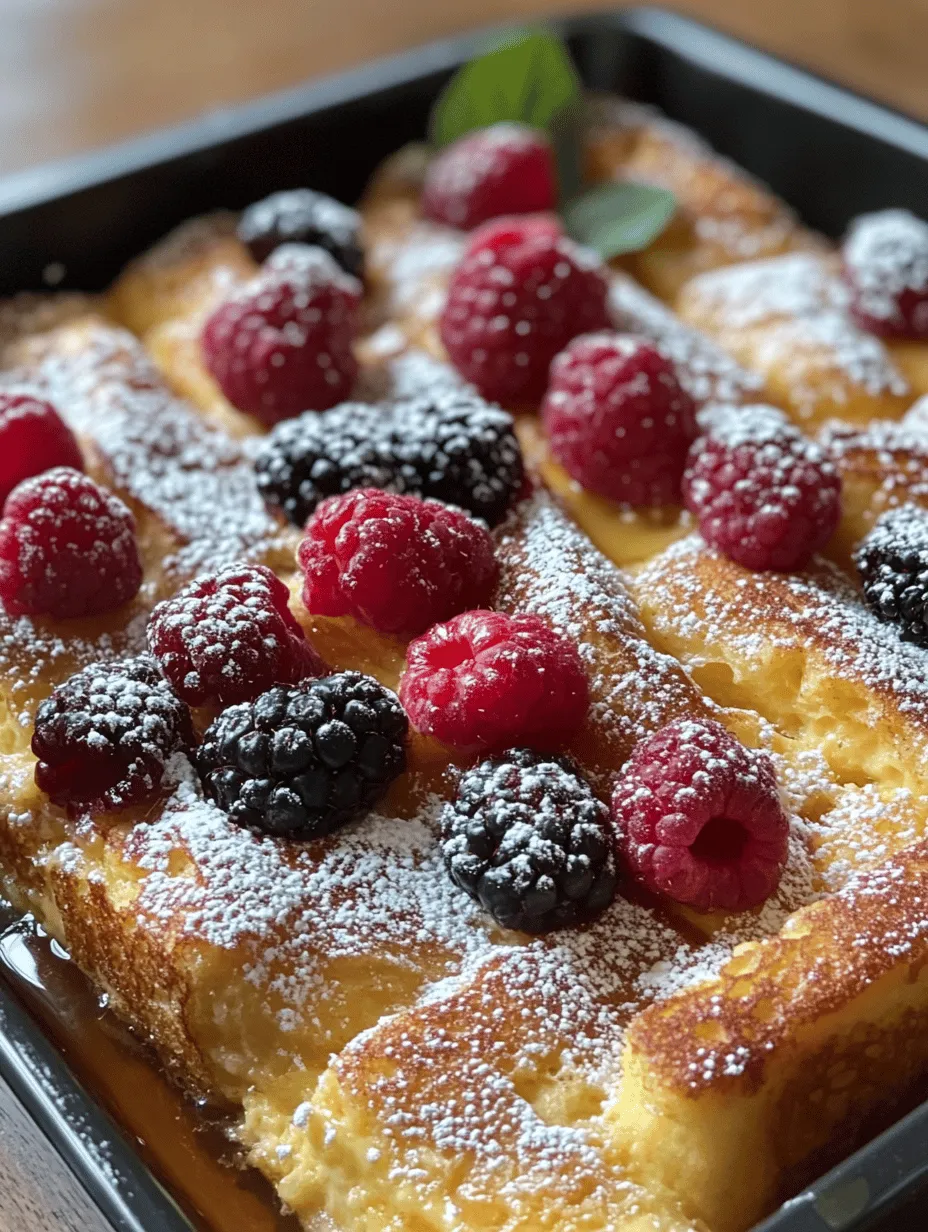Introduction to Overnight French Toast Casserole
The Overnight French Toast Casserole is a delightful twist on a classic breakfast favorite that has become a beloved dish in many households. Combining the rich, comforting flavors of traditional French toast with the convenience of a casserole, this dish allows you to enjoy a luxurious breakfast with minimal morning effort. Imagine waking up to the warm aroma of cinnamon and vanilla wafting through your home, knowing that a delicious meal is just a matter of baking away. This dish is perfect for family gatherings, brunch with friends, or even a cozy weekend breakfast at home.
One of the most appealing aspects of the Overnight French Toast Casserole is its ease of preparation. With a little bit of planning the night before, you can assemble all the ingredients, pop it in the refrigerator, and let it sit overnight. In the morning, simply bake it to golden perfection while you sip your coffee and enjoy some leisurely morning moments. This makes it an ideal choice for busy mornings or special occasions where you want to impress without the stress.
Understanding the Ingredients
The success of any great casserole lies in the quality and selection of its ingredients. Below, we’ll delve into the key components of the Overnight French Toast Casserole and how each contributes to the overall flavor and texture of the dish.
Bread Selection: Brioche vs. Challah
Choosing the right bread is crucial for achieving the perfect texture and flavor in your Overnight French Toast Casserole. The two most popular choices are brioche and challah, both of which bring their own unique characteristics to the table.
Brioche is a rich, buttery bread that boasts a soft and slightly sweet flavor. Its airy texture and tender crumb allow it to soak up the custard mixture beautifully, resulting in a fluffy and decadent casserole. Additionally, brioche’s high fat content contributes to a luscious finish, making each bite feel indulgent.
On the other hand, challah is a traditional Jewish bread that is slightly denser than brioche, with a slightly sweet flavor profile. Its braided appearance is not only visually appealing but also provides a wonderful texture that holds up well during baking. The slightly chewy exterior and soft interior make challah an excellent choice for French toast casseroles.
Ultimately, the choice between brioche and challah comes down to personal preference. Both options yield a delicious dish, but experimenting with each can lead to discovering your favorite flavor and texture combination.
Eggs: The Binding Agent
Eggs are a fundamental component of the custard mixture in an Overnight French Toast Casserole. They serve as a binding agent, helping to create a cohesive structure that holds the bread together while it bakes. The protein in eggs coagulates during cooking, ensuring that your casserole has a firm yet tender consistency.
In addition to their structural role, eggs also offer several nutritional benefits. Using large eggs in your recipe not only provides essential proteins but also contributes vitamins and minerals such as vitamin D, B12, and choline. These nutrients are vital for maintaining energy levels and supporting overall health, making eggs an excellent choice for breakfast.
Dairy Elements: Milk and Heavy Cream
The creaminess of your Overnight French Toast Casserole largely hinges on the dairy elements used in the custard mixture. Both whole milk and heavy cream play pivotal roles in creating a rich and velvety texture. Whole milk contributes a satisfying creaminess without being overly heavy, while heavy cream adds an indulgent richness that elevates the dish to a new level of luxury.
For those with dietary restrictions or preferences, there are alternative dairy options available. Almond milk, coconut milk, or cashew cream can be utilized in place of traditional dairy to accommodate lactose intolerance or a vegan lifestyle. Just be sure to choose unsweetened varieties to maintain the desired flavor balance.
Sweeteners: Brown Sugar and Maple Syrup
When it comes to sweetening your Overnight French Toast Casserole, brown sugar is a popular choice due to its unique flavor profile. The molasses content in brown sugar imparts a deep, caramel-like sweetness that complements the spices and enhances the overall taste of the dish. It also helps to create a crispy, golden crust on top of the casserole during baking.
While the casserole itself is sweetened with brown sugar, maple syrup is the quintessential topping that many people enjoy drizzling over their servings. The natural sweetness and distinct flavor of pure maple syrup provide a delightful contrast to the richness of the casserole, making each bite a harmonious blend of flavors.
Spices: Cinnamon, Nutmeg, and Salt
Spices play a crucial role in enhancing the flavor of your Overnight French Toast Casserole. A combination of cinnamon and nutmeg adds warmth and depth, evoking the comforting essence of traditional French toast. Cinnamon, with its sweet and spicy notes, is a classic pairing for breakfast dishes, while nutmeg introduces a subtle earthiness that rounds out the flavor profile.
Moreover, a pinch of salt is essential for balancing the sweetness of the dish. Salt not only enhances the overall flavor but also helps to bring out the natural sweetness of the bread and custard mixture. Striking the right balance between sweet and savory is key to creating a well-rounded dish.
Optional Toppings: Fresh Berries and Powdered Sugar
One of the joys of serving Overnight French Toast Casserole is the opportunity for personalization with various toppings. Fresh berries, such as strawberries, blueberries, or raspberries, can add a vibrant burst of flavor and color to the dish. The tartness of the berries contrasts beautifully with the sweet casserole, creating a delightful balance.
Additionally, a light dusting of powdered sugar can elevate the visual appeal of your casserole, making it look even more inviting. Not only does it add a touch of elegance, but it also provides a hint of sweetness that enhances the overall experience of the dish. Feel free to get creative with toppings by adding nuts, whipped cream, or even chocolate chips for an extra indulgent twist.
Step-by-Step Preparation
Now that we’ve explored the essential ingredients of the Overnight French Toast Casserole, let’s dive into the preparation process. The following steps will guide you through creating this delicious dish from start to finish.
Preparing the Bread
The first step in preparing your casserole is selecting and preparing the bread. For the best results, it is advisable to use stale bread. Stale bread has a firmer texture that allows it to hold up better during the soaking process, preventing the dish from becoming overly soggy. If you don’t have stale bread on hand, you can easily create it by slicing fresh bread and allowing it to sit out for several hours or overnight to dry out slightly.
Once your bread is ready, it’s time to cube it. Cut the bread into uniform 1-inch cubes to ensure even distribution throughout the baking dish. This is important for achieving a consistent texture and ensuring that every bite is filled with delicious custard-soaked goodness. Gently place the cubed bread into a greased 9×13-inch baking dish, spreading it out evenly to avoid clumps.
Crafting the Custard Mixture
Next, it’s time to craft the custard mixture that will soak into the bread. In a large mixing bowl, combine the eggs, whole milk, heavy cream, brown sugar, vanilla extract, cinnamon, nutmeg, and salt. Using a whisk, blend the ingredients together until they are fully combined and smooth. This step is crucial for ensuring that all the flavors meld together, creating a cohesive mixture that will infuse the bread with flavor.
Once the custard mixture is well-combined, pour it evenly over the cubed bread in the baking dish. Use a spatula or your hands to gently press down on the bread, ensuring that each piece is fully saturated with the custard. This is where the magic happens—the bread will absorb the liquid overnight, allowing the flavors to develop and intensify.
After the bread has been sufficiently coated, cover the baking dish with plastic wrap or aluminum foil and place it in the refrigerator. Allow it to soak overnight, or for at least 4 hours, to achieve the best flavor and texture in your casserole.
As the mixture rests, the bread will absorb the custard and become soft and flavorful, setting the stage for a delightful breakfast experience in the morning. With the preparation complete, you’re well on your way to serving a delicious Overnight French Toast Casserole that will impress your family and friends alike.
Stay tuned for the next part of this article, where we’ll walk through the baking process and share tips for the best results.

Whisking Technique for Best Results
To achieve the perfect custard for your Overnight French Toast Casserole, the whisking technique is vital. Start by cracking your eggs into a mixing bowl, ensuring they are at room temperature. This helps them blend more uniformly with the other ingredients. Whisk the eggs vigorously until they are fully combined and slightly frothy, indicating that air is being incorporated. This step is crucial as it contributes to the lightness of the casserole.
Next, slowly add milk (or your chosen alternative) along with vanilla extract and a pinch of salt. Continue whisking until all ingredients are thoroughly mixed. The key here is to avoid over-whisking; you want to blend the flavors without creating too many bubbles, which can lead to an uneven texture in the final bake.
Combining Bread and Custard
Once your custard is ready, it’s time to combine it with your bread. Choose a sturdy bread, such as brioche or challah, as they hold up well when soaked. Cut the bread into cubes, roughly one-inch in size. This uniformity ensures that each piece will absorb an equal amount of the custard.
When adding the bread to the custard mixture, use a large mixing bowl to allow for easy mixing. Gently fold the bread cubes into the custard using a spatula. The goal is to coat each piece thoroughly without breaking them apart. This careful folding technique ensures that every cube is enveloped in the rich custard, maximizing flavor and moisture retention.
Importance of Thorough Coating and Submersion
Thoroughly coating the bread in the custard is essential for the casserole’s success. Each piece of bread should be submerged in the mixture, soaking up the flavors. This is key to preventing dry spots in the casserole. If your bread isn’t adequately coated, you may end up with sections that are overly dry or not as flavorful.
To ensure the best coating, after folding the bread into the custard, allow it to sit for a few minutes. This resting time enables the bread to absorb the liquid fully. If you notice that some pieces are still floating at the top, gently press them down with a spatula or the back of a spoon to encourage complete submersion.
Tips for Avoiding Dry Spots
To avoid dry spots in your Overnight French Toast Casserole, follow these tips:
1. Use Stale Bread: Day-old bread or slightly stale bread is ideal for this recipe, as it absorbs the custard better than fresh bread.
2. Cut Uniform Pieces: Ensure your bread cubes are uniform in size to promote even soaking.
3. Press Down: After mixing, press down on the bread cubes to ensure they’re submerged. This step can be repeated a couple of times as the bread soaks.
4. Cover and Refrigerate: Once combined, cover your bowl tightly with plastic wrap or a lid and refrigerate. This chilling process helps the bread absorb the custard overnight.
Chilling Process: Overnight Soaking
The chilling process is where the magic happens. By letting the casserole soak overnight, the bread has ample time to absorb the custard mixture fully. This soaking allows the flavors from the eggs, milk, and spices to penetrate the bread, resulting in a richer taste and a softer texture.
While the minimum soaking time is around 4 hours, if you can manage to let it sit overnight, you will notice a significant improvement in flavor and texture. Ideally, prepare your casserole the night before you plan to serve it, allowing it to soak for at least 8 hours.
Baking the Casserole
Preheating the Oven
Before you start baking, preheat your oven to 350°F (175°C). Preheating is critical for even baking, ensuring that the casserole cooks uniformly throughout. An adequately preheated oven allows the custard to set properly, resulting in a fluffy, golden-brown top while keeping the inside moist.
Baking Instructions
Once your oven is preheated, remove the casserole from the refrigerator. If desired, sprinkle additional cinnamon or nutmeg on top for an extra layer of flavor. Bake the casserole for 45 to 55 minutes, or until the top is golden brown and a knife inserted in the center comes out clean. Keep an eye on it towards the end of the baking time to prevent over-browning.
Visual cues for doneness include a puffed-up appearance and a firm texture in the center. If you notice that the top is browning too quickly, you can cover it loosely with aluminum foil during the last 15 minutes of baking.
After baking, allow the casserole to cool for about 10 to 15 minutes before serving. This cooling period helps the custard to settle, making it easier to slice and serve.
Serving Suggestions and Presentation
Garnishing the Casserole
Presentation is key when serving your Overnight French Toast Casserole. A light dusting of powdered sugar adds a touch of elegance and sweetness. To dust powdered sugar effectively, use a fine mesh sieve or a sifter and hold it a few inches above the casserole, allowing a light, even coating.
For a burst of freshness, consider serving the casserole with a side of mixed berries. Strawberries, blueberries, and raspberries not only add color but also complement the sweet flavors of the dish beautifully. Drizzle with maple syrup or a fruit compote for an indulgent touch.
Pairing Ideas
To enhance the breakfast experience, consider beverage pairings. A hot cup of coffee or a refreshing glass of orange juice pairs well with the richness of the casserole. For a more relaxing morning, herbal teas like chamomile or chai can also be delightful accompaniments.
As for side dishes, crispy bacon or sausage links provide a savory contrast to the sweet casserole. A simple green salad can also be a refreshing addition, balancing out the richness of the meal.
Nutritional Information
Calories and Macronutrients
When it comes to enjoying your Overnight French Toast Casserole, understanding its nutritional profile can help you make informed choices. On average, one serving of this casserole contains approximately 300 to 400 calories, depending on the specific ingredients used, such as the type of bread and milk.
Each serving typically includes around 15 grams of protein, 40 grams of carbohydrates, and 10 grams of fat. This hearty breakfast not only provides energy to kickstart your day but also includes essential nutrients from the eggs and dairy.
Dietary Modifications
If you’re looking to adapt this recipe to suit different dietary needs, here are a few suggestions:
– Gluten-Free: Use gluten-free bread to make this casserole suitable for those with gluten sensitivities. Ensure the other ingredients, like milk and vanilla extract, are also gluten-free.
– Vegan: Substitute eggs with a mixture of ground flaxseed and water (1 tablespoon of flaxseed mixed with 2.5 tablespoons of water equals one egg). For the milk, use almond milk, oat milk, or any other plant-based alternative.
– Lower Sugar: For those looking to reduce sugar intake, consider using a sugar substitute or reducing the amount of sugar in the custard. You can also enhance sweetness with natural fruit toppings.
Conclusion: The Joy of Overnight French Toast Casserole
The Overnight French Toast Casserole is more than just a breakfast dish; it’s a delightful way to start your day or impress your guests at brunch. Its convenience lies in the ability to prepare it the night before, allowing flavors to meld and the bread to absorb the custard fully.
Encouraging experimentation with various flavors and toppings—including chocolate chips, nuts, or seasonal fruits—can make this dish a versatile staple for any occasion. Whether you’re hosting a holiday gathering or enjoying a quiet family breakfast, this casserole is sure to please. Dive into the joy of cooking and make this recipe a beloved addition to your culinary repertoire.



